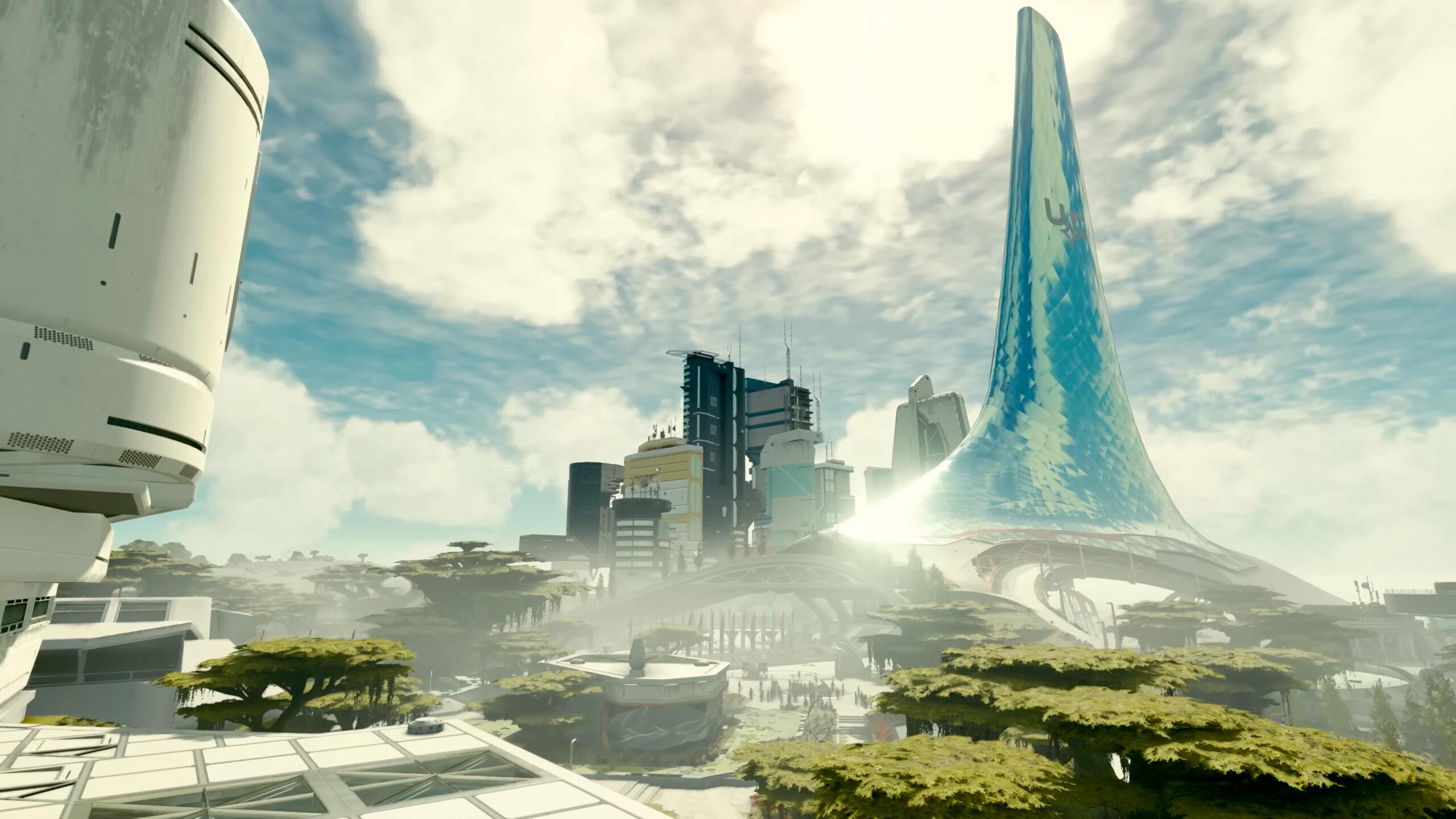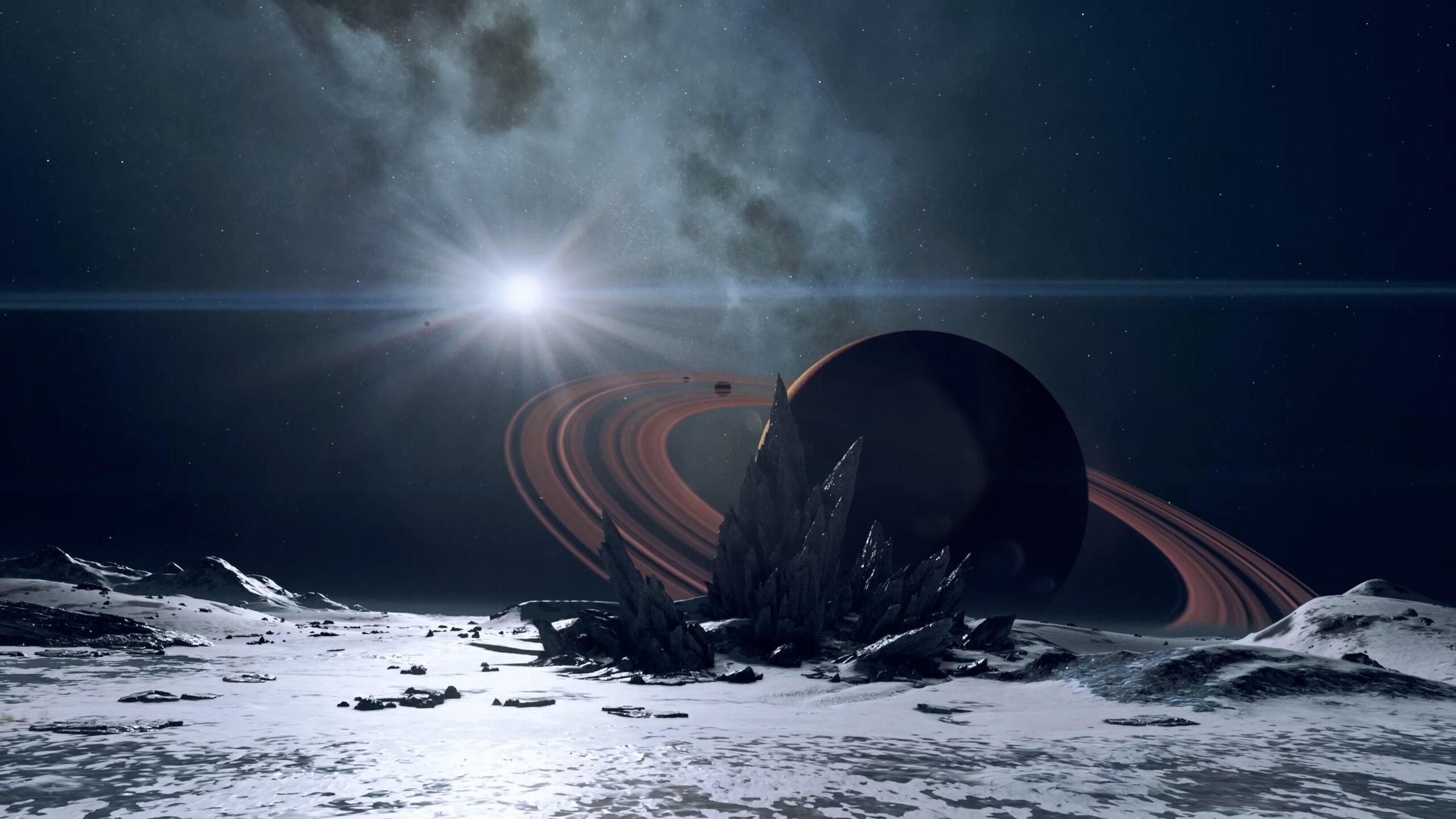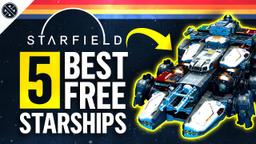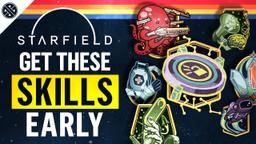The Ultimate Planetary Odyssey: 1000+ Planets, Thriving Cities, and Personal Outposts
Written by - Codiak
Updated: July 24, 2023
|
Posted: July 12, 2023

A Starfield Ultimate Preview Series – Part 3
If you’re just jumping into our Ultimate Preview Series, we’d advise you read our previous articles in the series if you’d like a better understanding of where your journey begins.
Part 1 – Your Journey Begins Here
Part 2 – A Cosmic Journey of Love, Customization, and Companionship Among the Stars
One hallmark of any Bethesda game are the incredible cities, and colorful factions players will run across during their adventures. Starfield is no different. As we’ve talked about before, our part in this grand space opera takes place 30 years after a bloody civil war between the United Colonies and the Freespace Collective, the two largest factions in the game, but they are far from the only forces vying for power in this massive universe.
New Atlantis
The United Colonies base of operations is called New Atlantis and according to the developers it’s the largest city the Bethesda team has ever created, not just in sheer size, but in density of artwork, crowds, and quests. Needless to say, I imagine we’ll be spending many hours traveling back to the Alpha Centauri System, where New Atlantis resides, as we crisscross the stars.




From a design perspective this is the most futuristic city we’ve seen in the game, but there is a very real 60’s flair that keeps everything from the building to the people grounded in the overall aesthetic of the game. One thing notable about the city is its use of verticality. So far, it’s the only location in the game where you can see buildings towering over the people below, and the curvature and heavy use of cool colors, specifically whites and grays, really gives you a sense that this is a “space city.” The people of New Atlantis value law, discipline, and the legacy of humanity and believe they are the true “children of Earth”.
This is where our story with Constellation begins, and part of the reason why we’ll most likely be back here so often as it’ll be a crossroads to the overarching story within the game.
UC Vigilance

Also tied to the United Colonies is the UC Vigilance, a massive military ship that players can visit, and while not a major city, I thought it was worth pointing out as there’s a lot of hype around this location online. It’s a massive, military ship and it appears it’ll have some significance to the UC faction, but it does beg the question, why do the United Colonies still need a massive armada of military battleships, especially decades after a conflict that’s seemingly over? Something to think about.
Akila City




Within the Cheyenne System is Akila City, the largest settlement controlled by the Freestar Collective. Keep in mind the Freestar Collective is a loose collection of 3-star systems and much less structured than that of the United Colonies, at least as far as we know right now.
As you can no doubt tell there is a much different vibe to this city, seemingly inspired by the old west back on Earth. There’s also a clear connection to one of Bethesda’s other games here, Fallout. You can see the inspiration everywhere from the dilapidated buildings, to the signage, to the interiors of buildings filled from wall to wall with knickknacks and baubles.
One interesting thing about Akila City is that it’s built on a relatively hostile planet, and while it is surrounded by a defensive wall, outside the city limits are feral aliens that the developers lovingly describe as a cross between a wolf and velociraptor…terrifying.
Neon




Another city we’ll frequent is called Neon in the Volii System. Originally intended as a fishing platform constructed by the Xenofresh Corporation, it’s now a pleasure city with all the trappings of a place like Vegas, just in space. Neon has a really interesting backstory, and that will no doubt be part of its narrative arc when it comes to questing. During its original fishing venture, the corporation discovered that one type of fish had psychotropic effects, allowing for the creation of a drug called Aurora which is only legal on Neon. Well obviously, drugs sell better than fish, and the rest is history, Neon doubled down on Aurora, and thus, thrived.
As far as it’s aesthetic goes, it’s a city clearly inspired by Shinjuku, Japan one of the busiest, most vibrant cities in that country, and while we’ve only seen a small fraction of Neon, there’s a strong east-Asian influence that permeated everything from the buildings and artwork, to the culture.
Cydonia

Other cities that we know of include Cydonia, which is more of a mining facility than anything else. Controlled by the United Colonies, and located on Mars of all places, it’s clear this is a place of industry with very little in the way of personal amenities. It’s unclear just how big Cydonia actually is in the game, but we know it’s a location we’ll have the opportunity to visit.
The Red Mile

Another interesting location is called The Red Mile in the Porrima system. Based on everything we know of this strange location it’s centered around some extravagant, and most likely, deadly race where players enter some sort of space obstacle course and compete for their life. It’s unclear who heads up the operations here, and what exactly its occupants are doing. Across the internet speculation abounds about it being a casino surveillance operation, other’s a death-race, but one thing is for certain, it’ll sure be exciting when we eventually find out.
The Key

Finally, I wanted to mention The Key in the Kyrx System, home to the Crimson Fleet. The faction are essentially space pirates, and while I’m sure they’re motivated by credits, they’re not quite the mercenaries of another faction, The Ecliptic. Once a United Colonies star yard, The Crimson Fleet clearly have a desire to overthrow the established order, no matter what it takes. It’s a ruthless group of thugs, and while I’m sure you can align with them, you better watch your back.
Exploring 1000+ Planets
Cities and established locations will no doubt be the center of questing and interesting interactions, but it’s the great beyond that I’m sure will entice a great many of you excited to check out Starfield. As you no doubt have heard, Starfield will have over 1000 planets for players to explore, more than any other space game currently released. Each will challenge players with unique obstacles, as well as entice them with potential opportunities, but it’s up to each individual to navigate the stars and explore every planet.
Previously, we discussed how players will move between stars, using their ship’s grav drive to jump between systems, but now I think we should drill down a bit deeper to the system and planet view and talk about what to expect before landing your ship on the surface of an alien world.
Within the system view you can see all of the planets in a star system, and at-a-glance gleam important information necessary before touching down. In a recent interview with Kinda Funny Games Todd Howard confirmed that only about 10% of planets will have life on them, and in this view you’re actually able to see if a planet has flora, fauna, and water. You’ll also get a sense for what resources are on the planet, which could help inform where you set up your outposts.
If we zoom in a layer we can see even more about a specific planet, including any points of interest that might entice you to visit the surface. It’s here where you can choose your landing spot, or fast travel to known locations. Planetary view also allows you to toggle on a resource overlay which shows you where the planet’s resources are located so that you don’t end up wandering the entire planet searching for something specific you might need.




If a planet does have life, that is flora and fauna, it presents a unique opportunity for you, as the player, to survey the planet. By surveying an entire planet you’ll receive a healthy chunk of credits that you can then use for any number of things. The planets themselves are procedurally generated, so no two experiences on any given planet will be exactly the same. That being said, not everything is procedurally generated and all of the major set pieces, and of course main story elements, are handcrafted.
It’s hard to nail down exactly how the procedural generation works, and that goes for the flora and fauna as well. The team has said that there are a set of rules that dictate how and what generates on each planet, but from game-to-game players may encounter different things. This is also true for the buildings. You may experience a set of points of interest on one planet, but someone else may encounter those same points of interest somewhere else.

Again, there is a set of complicated rules that dictate this aspect of exploration and truly it’s the secret sauce that could make the Starfield experience one of a kind. Truthfully, we don’t know how deep this system goes, and how it’s dictated, that’s a secret only the developers know, and at this point it’s unlikely that they’ll share the inner workings of something so monumentally important to the game.
What was showcased was a player fully exploring and clearing a point of interest, and by all accounts this looks like an incredible way to score some important gear on your adventure. There’s no way you’d ever miss out on exploring a deserted robotics lab, but the risk has to be worth the reward and the developers showcased, in this instance, the legendary loot, an incendiary calibrated deep mining space helmet, that’s awaiting the player for their hard work and prowess.

If combat isn’t your thing and you prefer a more peaceful approach to your planetary exploration, then there is always surveying. As I mentioned previously by completely surveying a planet you’ll gain credits, but there’s also a benefit to surveying flora and fauna, to better understand their nature, where else you can find them in the galaxy, and most importantly, what resource they’ll yield when harvested.
Surveying isn’t a challenging task, you simply pull out your viewfinder, aim and scan. It’s a simple system that I imagine some will find tedious, other’s incredibly satisfying and rewarding. There is certainly no shortage of things to survey, including an abundance of strange flora and fauna that will feel natural to the exotic worlds players will visit.
Outpost System
While surveying there’s a good chance you’ll become enamored by a specific planet, and that’s ok too, because Starfield’s outpost system allows you to set down roots on nearly every world you visit. Again, this is a Bethesda hallmark at this point with base building systems becoming a constant in their last few games.
This time around things are a bit different as we’re creating futuristic habitat modules, not slapping up ramshackled walls and calling it a home. From a gameplay perspective the most interesting aspect of outposts are the extractors which allow you to passively harvest resources natural to the planet. If you find the right location and set up the base in the right way I imagine this will be incredibly lucrative.
Once your outpost beacon is established the sky is really the limit, and one of the new features introduced by the developers into Starfield is a fly-cam that allows players to build from a top/down perspective. You can still build in first or third-person mode, but this is a new vantage point for players to explore.




There are at least 12 categories of outpost buildings and decorations that players will have access to, and while on a macro level habitat, or HABs as they’re called, will provide the overall structure, flow, and functionality of your outpost, you can still add and tweak more decorative things like couches and statues, so that your outpost feels like the space home you’ve always dreamed of.
While not entirely known there are serious gameplay implications for having an outpost established and as you can see in the build menu certain HABs will have limitations on how many can be deployed at a single outpost. I imagine anything that allows for research or resource regeneration will have upper limits as it would be a bit broken to create the world’s largest space farm on some distant moon…but hilarious, now that I think about it.
Previously we talked about companions, and they can be assigned to your outposts to help maintain your remote bases when you’re not around. We don’t know exactly what gameplay bonuses having companions work outposts will achieve, but we do know that outpost engineering is a skill companions can have and if I were to guess I would imagine it increases the overall speed or output of various stations around your base.

And while not said out loud anywhere that I can find, based on the various menus we’ve seen leading up to launch its clear players will be able to have multiple outposts scattered across multiple planets, perfect for the entrepreneurial space farmer in all of us.
Conclusion
Hopefully its clear, exploration is at the very heart of the Starfield experience, and while it’s certainly not the only thing driving the game forward, it’s easily one of the most accessible, and exciting, aspects of the game. Whether your goal is to align yourself with a faction, explore a major city, or set up an outpost there’s something to explore in every corner of the galaxy.






